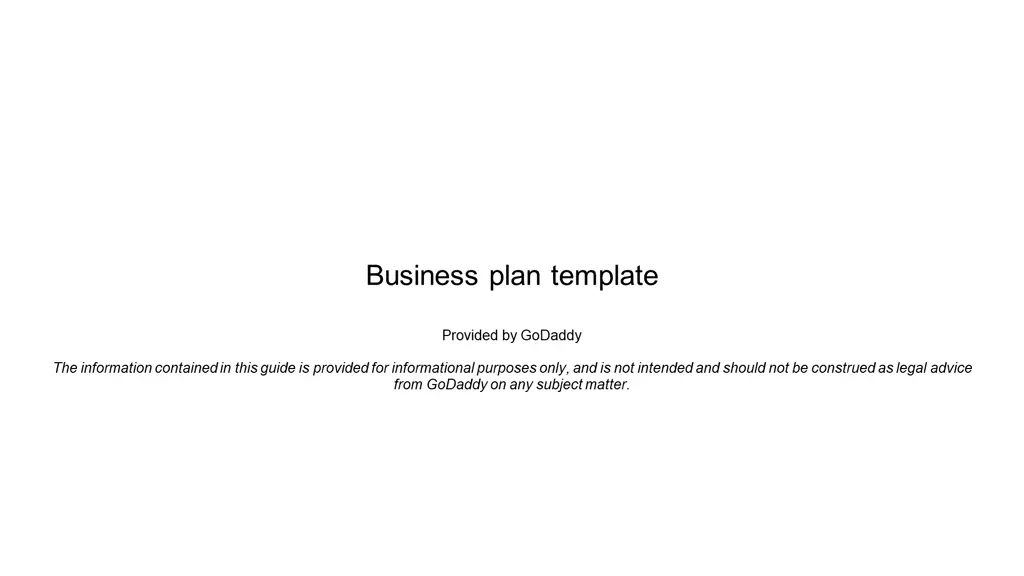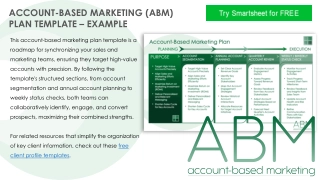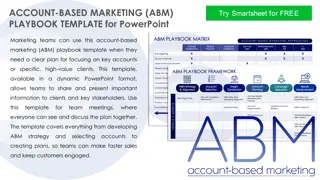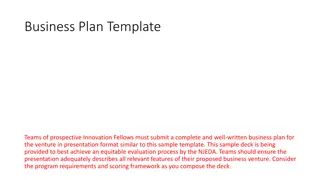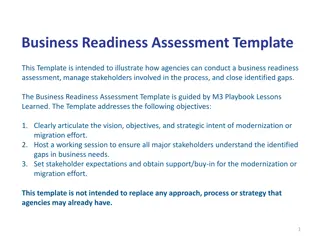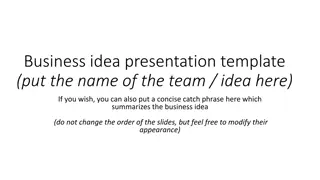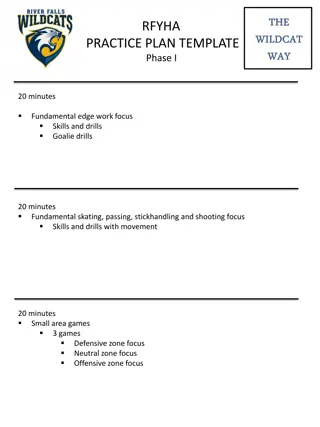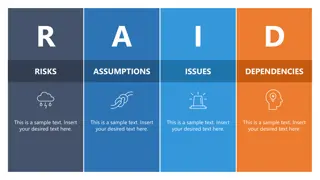Business plan template
A comprehensive business plan template provided by GoDaddy for informational purposes, offering guidance on structure, instructions, and examples.
Download Presentation

Please find below an Image/Link to download the presentation.
The content on the website is provided AS IS for your information and personal use only. It may not be sold, licensed, or shared on other websites without obtaining consent from the author.If you encounter any issues during the download, it is possible that the publisher has removed the file from their server.
You are allowed to download the files provided on this website for personal or commercial use, subject to the condition that they are used lawfully. All files are the property of their respective owners.
The content on the website is provided AS IS for your information and personal use only. It may not be sold, licensed, or shared on other websites without obtaining consent from the author.
E N D
Presentation Transcript
Business plan template Provided by GoDaddy The information contained in this guide is provided for informational purposes only, and is not intended and should not be construed as legal advice from GoDaddy on any subject matter.
How to use this template: Review the entire document and note its structure For each section, start by reading the instructions. For each section, read the example. Following the instructions, replace the example text with your own. Once complete, delete the instructions and example text. Save the document, including the name of your business.
Company logo Company name Written by: Your name here
Table of contents Executive Summary Company description Company goals Products and/or services Market research Marketing and sales plan Financial projection Appendix
Executive Summary Instructions: The executive summary of a business plan should include a brief overview of the company, its products or services, target market, competition, marketing and sales strategies, financial projections, and funding requirements. Also be sure to highlight the unique value proposition of the company and competitive advantages. The purpose of the executive summary is to provide a high-level overview of the business plan that captures the reader's attention and entices them to read further it should be concise, clear and engaging. Example: [Company Name] is an organic skincare company that offers high-quality, natural and sustainable skincare products. Our mission is to provide our customers with a healthier alternative to conventional skincare products that are often filled with harmful chemicals and toxins. Our products are made from certified organic ingredients, free from harmful chemicals and toxins, and are cruelty-free. We understand the importance of skincare and how it can impact our overall health and wellbeing. That's why we have carefully crafted our products using only the best ingredients to ensure that they are not only effective but also safe to use on all skin types. Our products include a range of skincare essentials such as cleansers, toners, moisturizers, serums, and more. We pride ourselves on our commitment to sustainability and have taken steps to ensure that our packaging is eco-friendly, and we use only recyclable materials. At [Company Name], we believe that beauty starts from the inside out. That's why we offer not only skincare products but also wellness products such as supplements, teas, and more. Our goal is to provide a holistic approach to beauty and wellness that our customers can trust. We understand that the skincare industry is highly competitive, but we believe that our commitment to quality, sustainability, and wellness sets us apart. We are dedicated to creating products that not only make our customers look good but also feel good about the impact they are making on the environment and their health. Our target market includes individuals who are health-conscious, environmentally aware, and seeking high-quality, natural skincare products. We plan to reach our customers through various marketing channels such as social media, online advertising, and collaborations with wellness influencers. We are excited to bring our passion for organic skincare and wellness to the market and look forward to building a brand that our customers can trust and rely on for years to come.
Company description Instructions: A company description in a business plan should provide a brief overview of the company, including its history, mission statement, products or services offered, target market, competitive advantages, and key team members. It should also highlight any notable achievements or milestones and outline the company's goals for the future. The description should give potential investors or partners a strong understanding of the company's value proposition and potential for growth. Example: Introducing the organic skincare line from [Company Name], crafted with the finest ingredients that nature has to offer. Our products are specially formulated to nourish and rejuvenate your skin, leaving it soft, supple, and radiant. At [Company Name], use only organic and ethically sourced ingredients in our skincare line, ensuring that our products are free from harmful chemicals, pesticides, and synthetic fragrances. Our ingredients are carefully selected to provide maximum benefits for your skin, with each product designed to target specific skin concerns. [Company Name] offers a variety of products, from gentle cleansers to luxurious moisturizers, all infused with natural botanicals, vitamins, and minerals. Our ingredients include aloe vera, chamomile, lavender, and rose, to name a few, which are known for their soothing, hydrating, and anti-inflammatory properties. We believe that taking care of your skin should be a holistic experience, which is why we focus on providing products that not only nourish your skin but also uplift your senses. Our products have a subtle, natural fragrance that comes from the essential oils and botanical extracts used in their formulation. With our organic skincare line, you can rest assured that you're using products that are not only good for your skin but also good for the environment. We are committed to using sustainable packaging and minimizing our carbon footprint, so you can feel good about your skincare routine knowing you're making a positive impact. Choose organic skincare from [Company Name] for a healthy, glowing complexion that comes from nature's goodness.
Company goals Instructions: The company goals section of a business plan should include a clear and specific statement of the company's long-term vision, mission, and objectives. It should outline the key performance indicators that the company will use to measure its progress towards achieving its goals and describe the strategies and tactics that will be employed to achieve those goals. Additionally, it should identify any potential challenges or risks that may impact the company's ability to meet its goals and provide a plan for addressing those risks. Overall, this section should demonstrate the company's ability to create value for its stakeholders and differentiate itself from competitors. Example: Increase Revenue: Our primary goal is to increase revenue by 20% over the next year through increased sales and marketing efforts, as well as expanding our product line to meet customer demand. Improve Customer Satisfaction: We aim to achieve a customer satisfaction rating of 95% by the end of the year by providing excellent customer service, addressing customer concerns promptly, and offering high-quality products. Expand Market Reach: We plan to expand our market reach by targeting new customer segments and expanding our geographical footprint. Our goal is to enter three new markets by the end of the year. Enhance Employee Engagement: We strive to create a positive and engaging work environment that fosters teamwork, innovation, and growth. Our goal is to increase employee satisfaction by 15% by implementing employee recognition programs, professional development opportunities, and improving communication channels. Increase Operational Efficiency: We aim to streamline our operations and reduce costs by implementing new technology and process improvements. Our goal is to reduce operational costs by 10% by the end of the year. Enhance Brand Awareness: We plan to enhance our brand awareness and increase customer loyalty through targeted marketing campaigns, social media engagement, and strategic partnerships. Our goal is to increase brand recognition by 25% over the next year. Foster Sustainable Practices: We are committed to environmental sustainability and aim to reduce our carbon footprint by implementing sustainable practices in our operations. Our goal is to reduce our carbon emissions by 20% by the end of the year. 1. 2. 3. 4. 5. 6. 7.
Products and/or services Instructions: The products/services section of a business plan should include a clear and detailed description of the products or services that the business offers, including their features, benefits and unique selling points. This section should also outline the target market for the products or services, as well as any relevant industry trends or competitive factors that may affect the business. Additionally, the section should discuss the pricing strategy and any plans for future product/service development or expansion. Example: At [Company Name], we offer a range of natural skincare products infused with botanicals, vitamins, and minerals like aloe vera, chamomile, lavender, and rose. Our focus on quality, sustainability, and wellness sets us apart in the competitive skincare industry. Our target audience is health-conscious and environmentally aware individuals seeking high-quality, natural skincare. We'll reach them through social media, online advertising, and wellness influencer partnerships. Our product lineup includes: Soothing Chamomile Cleanser - This gentle, yet effective cleanser is infused with organic chamomile extract to soothe and calm irritated skin. It effectively removes dirt, oil, and makeup, leaving your skin feeling clean and refreshed. Hydrating Rose Toner - This hydrating toner is formulated with organic rose water to soothe and hydrate your skin. It helps to balance your skin's pH levels and prepares your skin for optimal absorption of your other skincare products. Renewing Vitamin C Serum - This powerful serum is packed with organic vitamin C, which helps to brighten and even out your skin tone. It also contains antioxidants that protect your skin from environmental damage and promote collagen production for a more youthful appearance. Nourishing Aloe Vera Moisturizer - This lightweight, non-greasy moisturizer is infused with organic aloe vera to hydrate and soothe your skin. It's perfect for all skin types and provides long-lasting hydration. Clarifying Tea Tree Oil Spot Treatment - This spot treatment is made with organic tea tree oil to help clarify and soothe blemished skin. It effectively targets acne and helps prevent future breakouts. Rejuvenating Ginseng Eye Cream - This luxurious eye cream is formulated with organic ginseng extract to reduce the appearance of fine lines and wrinkles around the eyes. It also helps to reduce puffiness and dark circles for a more refreshed look. Calming Lavender Body Lotion - This organic body lotion is infused with lavender extract to soothe and calm your skin. It's lightweight and absorbs quickly, leaving your skin feeling soft and hydrated. Exfoliating Bamboo Scrub - This organic scrub is made with bamboo extract to gently exfoliate and remove dead skin cells. It also contains organic coconut oil and shea butter to leave your skin feeling smooth and hydrated.
Market research Instructions: The market research section of a business plan should include an analysis of the industry and market in which the business operates, including an assessment of the target market's needs, preferences, and buying habits. This section should also outline any relevant trends, competition, and regulatory factors that may impact the business. Additionally, the section should discuss any primary or secondary research conducted to gather data on the market and target audience, as well as any conclusions or insights derived from that research. The goal of this section is to demonstrate a thorough understanding of the market and how the business fits into it. Example: Industry Overview: The organic skincare industry is a rapidly growing segment within the larger skincare market. According to a report by Grand View Research, the global organic personal care market size is expected to reach $25.1 billion by 2025, growing at a CAGR of 9.5% from 2019 to 2025. In addition, consumer demand for natural and organic products is on the rise, as people become more aware of the potential health risks associated with conventional skincare products. Competitive Analysis: We conducted a competitive analysis of other organic skincare brands in the market. Our research found that the top players in the market include brands such as [Example Competitor #1], [Example Competitor #2], [Example Competitor #3], and [Example Competitor #4]. These brands have a strong presence in the market and offer a range of organic skincare products. However, we found that there is still a gap in the market for affordable, high-quality organic skincare products that cater to a wider range of consumers. Target Market: To determine our target market, we conducted a survey of 500 people aged between 18 and 45. Our research found that there is a growing demand for organic skincare products among millennials and Gen Z consumers who are concerned about the environment and their health. Our target market consists of consumers who are willing to pay a premium for organic products that are sustainably sourced, cruelty-free, and free of harmful chemicals. Marketing Strategy: Based on our research findings, we plan to focus our marketing efforts on social media platforms such as Instagram, Facebook, and Twitter, where our target audience is most active. We also plan to collaborate with influencers and bloggers in the beauty and wellness niche to promote our products. In addition, we will attend beauty and wellness events to showcase our products and build brand awareness. Conclusion: In conclusion, our market research has shown that there is a growing demand for organic skincare products, and our target market consists of environmentally conscious consumers who are willing to pay a premium for high-quality, organic products. By focusing on social media marketing, influencer collaborations, and attending beauty and wellness events, we believe we can successfully launch and grow our new organic skincare line.
Marketing and sales plan Instructions: The marketing and sales section of a business plan should include a detailed plan for promoting and selling the products or services offered by the business. This section should outline the target audience and how the business plans to reach and communicate with them, as well as the pricing strategy, sales channels, and promotional tactics that will be used. It should also include an analysis of the competition and how the business plans to differentiate itself and create a unique value proposition. Additionally, this section may include sales forecasts and projections, as well as any metrics or KPIs that will be used to measure the effectiveness of the marketing and sales efforts. The goal of this section is to demonstrate a clear and effective strategy for generating revenue and achieving business objectives. Example: Marketing and sales are essential elements of any business plan. In this section, we will outline the marketing and sales plan from [Company Name] for our new organic skincare line. Marketing Plan: Product Positioning: We will position our organic skincare line as a premium, high-quality product that is sustainably sourced, cruelty-free, and free of harmful chemicals. Our product will cater to consumers who are environmentally conscious and concerned about their health. Social Media Marketing: We will use social media platforms such as Instagram, Facebook, and Twitter to reach our target audience. We will create engaging content that highlights the benefits of our organic skincare line and promotes our brand values. We will also run targeted social media ads to reach a wider audience. Influencer Collaborations: We will collaborate with influencers and bloggers in the beauty and wellness niche to promote our products. We will provide them with free samples of our product and ask them to review and promote our products on their social media channels. Email Marketing: We will use email marketing to keep our customers informed about our products and promotions. We will also use email marketing to collect feedback from our customers and improve our products. Sales Plan: Online Store: We will set up an online store to sell our products directly to customers. Our website will be user-friendly and feature high-quality product images and detailed product descriptions. We will also offer free shipping on all orders to encourage customers to purchase our products. Retail Partnerships: We will partner with select retailers that align with our brand values to expand our distribution channels. We will also provide retailers with promotional materials and in-store displays to promote our products. Subscription Service: We will offer a subscription service where customers can receive our products on a regular basis. This service will provide a steady stream of revenue and help us retain customers. Loyalty Program: We will implement a loyalty program to reward our customers for their loyalty. The program will offer discounts, exclusive promotions, and other perks to incentivize customers to continue purchasing our products. Conclusion: Our marketing and sales plan for our organic skincare line includes social media marketing, influencer collaborations, email marketing, an online store, retail partnerships, a subscription service, and a loyalty program. By focusing on these strategies, we believe we can successfully launch and grow our new organic skincare line and reach our target audience of environmentally conscious consumers.
Financial projections Instructions: The financial projection section of a business plan should include a detailed forecast of the business's financial performance over a specific period, usually three to five years. This section should include projections for revenue, expenses, profits, and cash flow, as well as an analysis of the assumptions and factors that underlie these projections. Additionally, this section may include a break-even analysis, balance sheet, and income statement. It should also highlight any funding needs or potential sources of financing, such as loans, investments, or grants. The goal of this section is to demonstrate the financial viability and potential return on investment of the business to potential investors, lenders, or stakeholders. Example: Assumptions: Our business projection is based on the following assumptions: We will launch our organic skincare line in Q1 of the upcoming year. We will have an initial investment of $500,000 to cover product development, marketing, and other startup costs. Our revenue will come from direct online sales, retail partnerships, and subscriptions. Our expenses will include product development costs, marketing expenses, salaries, and overhead costs. Our projections cover a period of three years. Year 1: Revenue: We expect to generate $750,000 in revenue in the first year. Expenses: Our total expenses are expected to be $600,000 in the first year, resulting in a net profit of $150,000. Key Metrics: We expect to have 5,000 direct online sales, 10 retail partnerships, and 500 subscribers by the end of the first year. Year 2: Revenue: We expect to generate $1.5 million in revenue in the second year. Expenses: Our total expenses are expected to be $900,000 in the second year, resulting in a net profit of $600,000. Key Metrics: We expect to have 15,000 direct online sales, 25 retail partnerships, and 2,500 subscribers by the end of the second year. Year 3: Revenue: We expect to generate $3 million in revenue in the third year. Expenses: Our total expenses are expected to be $1.8 million in the third year, resulting in a net profit of $1.2 million. Key Metrics: We expect to have 25,000 direct online sales, 50 retail partnerships, and 5,000 subscribers by the end of the third year. Conclusion: Based on our business projections, we expect to generate steady growth over the next three years. We will continue to invest in product development, marketing, and partnerships to achieve our revenue goals. Our projections demonstrate that our organic skincare line has strong growth potential and can become a successful and profitable business.
Appendix Instructions: The appendix of a business plan should include any additional supporting documents that provide more detailed information or evidence to support the claims or statements made in the main sections of the plan. This may include resumes or bios of key team members, legal documents such as licenses or patents, market research data or surveys, detailed financial statements, product or service specifications, marketing materials, or any other relevant information that could help to clarify or bolster the plan's contents. The appendix is an optional section, but it can be useful for investors or lenders who want to dig deeper into the details of the business plan. Example: Meet Emily, the founder of Elysium, a natural skincare line that has taken the beauty industry by storm. Emily has always had a passion for natural and holistic approaches to health and wellness, which eventually led her to develop her own line of skincare products that are gentle, effective, and safe for all skin types. After earning her degree in organic chemistry, Emily worked for several years in the pharmaceutical industry, but she always felt unfulfilled by the corporate culture and the emphasis on profits over people. So, she decided to take a leap of faith and start her own business, combining her love of science with her desire to help people feel beautiful and confident in their own skin. Emily's commitment to quality and transparency is evident in every aspect of Elysium, from the carefully selected ingredients to the eco-friendly packaging. She spends countless hours researching and testing new formulas, always striving to create products that are not only effective but also sustainable and ethical. In her free time, Emily enjoys hiking in the mountains, practicing yoga, and experimenting with new recipes in the kitchen. She is also passionate about giving back to her community, and regularly donates a portion of Elysium's profits to organizations that support environmental conservation and social justice. Through her dedication and vision, Emily has built a thriving business that is changing the beauty industry for the better, one glowing complexion at a time.
